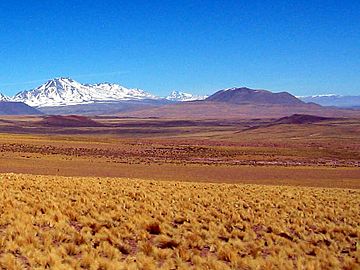Pular (volcano) facts for kids
Quick facts for kids Pular |
|
|---|---|

Miñiques surrounding area with Pular, Cerro Pajonales and Socompa in the distance.
|
|
| Highest point | |
| Elevation | 6,233 m (20,449 ft) |
| Prominence | 1,898 m (6,227 ft) |
| Listing | Ultra |
| Naming | |
| English translation | The Eyebrow |
| Language of name | Kunza |
| Geography | |
| Location | Antofagasta Region, Chile |
| Parent range | Andes |
| Geology | |
| Mountain type | Stratovolcanoes |
| Last eruption | Unknown |
| Climbing | |
| First ascent | Inca, pre-Columbian |
Pular is a huge stratovolcano (a tall, cone-shaped volcano) located in the Antofagasta Region of northern Chile. It's about 15 kilometers (9 miles) west of the border with Argentina. Pular and another mountain called Cerro Pajonales form a long line of volcanoes. This line stretches for about 12 kilometers (7.5 miles). Further south, you'll find the Socompa volcano. The top of this volcanic line separates two large salt flats: the Salar de Atacama basin and the Salar de Pular basin. The Salar de Pular basin is surrounded by the Aracar volcano to the east.
In the ancient Kunza language, Pular means "The Eyebrow." This volcano was an important place for the Inka people, who used it for cultural activities long ago.
About Pular Volcano
The Andes mountains in northern Chile are home to many volcanoes. Some of these volcanoes are very tall, reaching over 6,000 meters (about 20,000 feet) high. During winter, snow covers these mountains. However, the region is very dry, so the snow usually melts away in the summer. Only on the highest peaks, like Ojos del Salado and Llullaillaco, does ice remain all year.
How Pular Was Formed
The Pular volcano, along with Pajonales, makes up a massive volcanic area. This area is larger than 300 square kilometers (115 square miles). It is made of volcanic rocks called andesitic and dacitic rocks. These rocks sit on top of older layers of rock that have cracks, or faults, in them.
The Pular-Pajonales area has two main parts. One part is older and has been worn down a lot by weather. This includes the main Pular and Pajonales peaks. The other part is newer and made of volcanic domes. These domes are like rounded hills of lava. They can be up to 1 kilometer (0.6 miles) tall. One of these domes even sits on top of an old moraine (a pile of rocks left by a glacier). The older rocks in this area are about 3.9 million years old. One of the newer domes is about 1.8 million years old. There were some reports of an eruption in 1990, but this area is very remote.
Pular's Glacial Past
In the past, Pular was covered by large glaciers. You can still see many moraines (rock piles left by glaciers) around the mountain. Scientists have found traces of five glacier systems on the northwestern side and six on the southeastern side. These glaciers were quite long, reaching up to 6 kilometers (3.7 miles). They left moraines at elevations lower than 5,000 meters (16,400 feet). Today, a small snowfield (a patch of snow) remains on one of the southeastern slopes where a glacier used to be. Sometimes, temporary lakes filled with melted snow appear on the mountain.
See also
 In Spanish: Volcán Pular para niños
In Spanish: Volcán Pular para niños
- List of volcanoes in Chile
- List of Ultras of South America
- Caichinque
- Monturaqui crater
- List of andean peaks with known pre-columbian ascents


